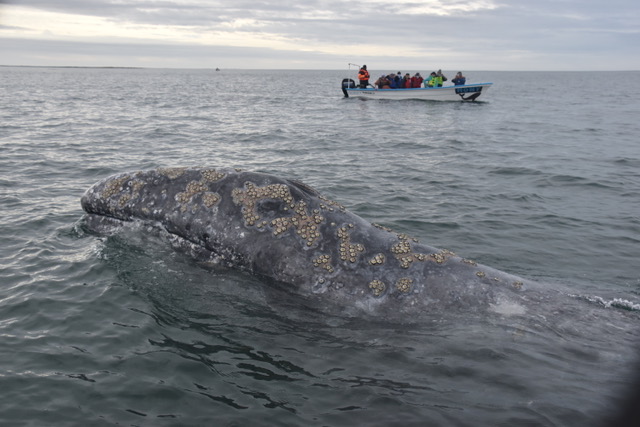Photo by Nancy Rhodes
ACS/LA GRAY WHALE CENSUS AND BEHAVIOR PROJECT: 2017-2018
Census Project Director/Coordinator: Alisa Schulman-Janiger
Email: janiger@cox.net
For daily sighting details, please visit: www.acs-la.org
Our third highest southbound calf counts and more Pacific white-sided dolphin sightings highlighted our 2017/2018 ACS/LA Gray Whale Census and Behavior Project. This is the 35th consecutive season that the American Cetacean Society’s Los Angeles Chapter has sponsored a full season gray whale census project from the Palos Verdes Peninsula. Our cliff-side post is on the patio of the Point Vicente Interpretive Center (PVIC), 138 feet above kelp beds and rocky shoreline, with a seafloor that drops off abruptly near shore. Citizen scientists – trained volunteers – collect data on gray whales and other cetaceans (identifications, counts, and behaviors). All participants use binoculars (most with reticles and compass); some also use spotting scopes to confirm and detail sightings. Weather data (visibility, weather conditions, and sea conditions), is recorded at least twice hourly.
COVERAGE: Our census station operated for 2,098 hours over the 176 days between 1 December 2017 and 25 May 2018 averaging nearly 12 hours/day). The 109 volunteers contributed 9,926 effort hours. The twelve core volunteers donated over
200 hours each, totaling 34.2% of our effort hours (and the number of volunteered days) include: Joyce Daniels (127), Gregg Gentry (118), Mike Malone (90), Sheila Parker (74), Bob Jensen (73), Gerrie Teague (69), Libby Helms (66), Chad Sprouse (65), Cynthia Woo (58), Alisa Schulman-Janiger (53), Gordon Gates (49), and Christy Varni (47). Thirty additional volunteers donated 100-199 hours each, totaling 35.2% of our effort hours. Experienced observers anchor all shifts; 23 volunteers have been with us for at least 10 seasons.
GRAY WHALE COUNTS FELL: We spotted 929 southbound and 1,951 northbound gray whales (1,256 southbound and 1,990 northbound gray whales last season). This was our ninth highest southbound count, and our ninth highest northbound count. Whale counts have widely fluctuated over 34 previous seasons: southbound counts varied from 301-1,902, and northbound counts varied from 521-3,412. Although most of the ~26,960 gray whales (NMFS 2015-2016 estimate) migrate past California, we spot only a small proportion. Gray whales off Palos Verdes, especially adults, tend to travel further offshore – notably during the southbound migration. Northbound whales, particularly cow/calf pairs and juveniles, tend to hug the coastline. These trends, combined with extended springtime observation hours, produce higher northbound counts. Shifting migratory corridors and weather conditions result in annually fluctuating shore-based counts. The number of whales completing migration varies, and feeding ground conditions (especially ice coverage) affect migratory timing and corridors. Poor visibility drastically affects counts. Fog compromised visibility during portions of fewer days this season (59) than last season (69).
PEAKS AND TURN-AROUND DATES: The peak southbound count of 42 was on 19 January; our previous peak counts ranged from 15-98. We spotted 171 southbound whales during the peak southbound week of 10-16 February (218 last season, 10 days earlier). Our southbound migration started later and ended later. Instead of the typical gap, we had a huge overlap between migration phases (again). The official turn-around date (when daily northbound whales exceed southbound whales) was 23 February; northbound first exceeded southbound on 18 February. We spotted 126 northbound whales during the “southbound migration”, and 99 southbound whales during the “northbound migration”. Our peak northbound counts were 88 grays on 17 March, and 72 on 18 March (107 and 105 last season – our highest peak counts since March 1988)! Previous northbound peaks counts ranged from 20-152. We recorded 398 gray whales during the peak northbound week (main migration pulse) of 16-22 March (510 last season).
CALF COUNTS: We tallied our third highest southbound calf count, and our seventeenth highest northbound calf count! We spotted 61 newborn southbound calves (6.6% of southbound migrants) between 29 December-16 February, peaking with 7 calves on 19 January; peak week, 13-19 January, with 21 calves (123 whales). (Last season: 68 newborn calves: 5.4 % of the southbound migrants). Our record high southbound calf count occurred during the 1997-98 season (106 calves, 8.6% of southbound migrants). Previous southbound calf counts ranged from 3-60 (0.5%-8.9% of southbound migrants), with the lowest percentage (0.5%) in 1988-1989. We counted 104 northbound calves (5.3% of northbound migrants), between 6 March-24 May, peaking with 7 calves on 14 April. Last season we spotted 207 northbound calves (10.4% of northbound migrants); the previous season we tracked a record 341* northbound calves (13.4% of northbound migrants). Previous record calf counts included 260 northbound calves (22.9% of northbound migrants) in 2011-2012, and 222 calves (13.8% of northbound migrants) in 1996-97. Our other calf counts have ranged from 11-196 (0.9%-18.5% of northbound migrants). We recorded 27 cow/calf pairs (68 gray whales) between 20-26 April (60 pairs last season). This peak northbound week (cow/calf migration pulse) typically occurs 4-8 weeks later that the main pulse, which allows calves to nurse longer and strengthen swimming skills in Baja lagoons before initiating their perilous migration northward. **Probable additional gray whale calves: 5 more southbound calves, and 10 more northbound calves.
BEHAVIORS AND HUMAN INTERACTIONS: We saw whales milling, rolling, lunging, breaching, spyhopping, head lifting, pectoral flipper slapping, fluke slapping, tail throwing, playing in kelp (“kelping”), bubble blasting, mating, nursing behavior (calves surfacing on alternating sides of their moms), and pods separating and merging. Harassment: On 19 days, we witnessed 21 too-close approaches involving 29+ boats, some of which nearly hit whales; on 1 day, 2 jet skis nearly collided with 2 sightings totaling 6 rolling whales, and on 1 day a helicopter buzzed a whale. Gray whales clearly reacted to these close calls: nearly all changed travel direction (zig-zag, turned outward or inward). Some sped up or slowed down; milled; rolled; stopped rolling/interacting; lifted heads; became stealthy/low profile; disappeared. One whale breached – and one pooped!
LOWER COUNTS: although this season’s counts dropped, the overall trend is toward higher counts, which reflects trends reported by other coastal census stations – NMFS (National Marine Fisheries Service, conducts official gray whale census), and Gray Whales Count (Goleta). NMFS’s 2015-16 ENP population estimate was ~26,960, a 22% increase (5670 whales) since the 2010/11 estimate of 20,990; five year period includes >6000 calves (four highest calf years since 1994). Recent expanded ice-free habitat and high nutrient flow have likely created favorable feeding conditions. Gray whales were removed from endangered species list (1994). Population fluctuations, number of whales completing migration, weather conditions, and observer experience affect whale counts Gray whale population dropped with a major mortality event (1999, 2000), followed by three seasons of low calf production. Arctic warming led to a northward shift in distribution of gray whale prey (mud-dwelling shrimp-like amphipods): they thrive in cooler water, feeding on algae that fall from ice sheets. Gray whales shifted northward as they followed their prey. Strandings decreased and calf production increased. Gray whales sometimes ignore the initial migration cue (shortened daylight hours) so that they can rebuild blubber that allows them to fast during migration and on Baja nursery ground, and provides energy to withstand disease, storms, and killer whale attacks. Although our northbound calf count markedly dropped, overall gray whale calf recruitment remains healthy. It will be important to see if this drop in calf recruitment continues next season.
OTHER SPECIES SIGHTED: We spotted 9-11 other marine mammal species over 176 days (176 days last season), including three KILLER WHALE sightings and more sightings of Pacific white-sided dolphin. Comparing this season (to last season), we saw common dolphin on 161 days (151), bottlenose dolphin on 154-155 days, including leucistic “Patches” (134), fin whale on 108-118 days (107-113+), Pacific white-sided dolphin on 69-70 days (38), humpback whale on 37-39 days, including “Chompers” and her calf (24-25), blue whale on 15-18+ days (6-13+), *KILLER WHALES* on 3 days: 19 Dec, 24 and 27 Jan (1), Risso’s dolphin on 0-1 day (1), minke whale on 0-1 day (3-4), California sea lion on 170+ days (147), and harbor seal on 65+ days (43).
*KILLER WHALES – obtained ID images of Bigg’s (transient) killer whales, including CA51A “Aurora” and her family!
California Killer Whale Project: please help contribute to this citizen science research project!
*Please send photos/sighting data to: janiger@cox.net; I will match images to our Photo-ID catalog, notify you with results
PREVIOUS SEASONS – OTHER SPECIES SIGHTED: sperm whale, false killer whale, pilot whale, northern right whale dolphin, beaked whale, Dall’s porpoise, Steller sea lion, northern elephant seal, and southern sea otter.
GRAY WHALE INTERACTIONS: gray whales sometimes interacted with other marine mammals including bottlenose dolphin, common dolphin, Pacific white-sided dolphin, fin whale, and sea lion. We also observed mixed species groupings: different types of dolphin, dolphin with sea lion.. and other whales with dolphin/sea lion.
MISCELLANEOUS: Two peregrine falcons* were observed nearly daily, raised one chick. (*this is the third consecutive year we have documented nesting at PVIC). Osprey(s) were also seen on many days., and a tagged bald eagle on one day. Peregrines, ospreys, and bald eagles continue to recover from DDT (pesticide) contamination. Many days ended with green flash sunsets.
OBSERVERS’ HOURS: (*new observers): afternoon anchor Joyce Daniels (444), Gregg Gentry (435), Mike Malone (354), Census Project Director/Coordinator Alisa Schulman-Janiger (333), Libby Helms (332), Chad Sprouse (332), Gerrie Teague Cole (315), Cynthia Woo (311), Gordon Gates (254), Christy Varni (232), Bob Jensen (223), Sheila Parker (218), *Rob Gray (190), Tony Carrillo (169), Kathy Beckman (164), M’Liz Callender (157), Kathy Hill (156), Gina Lumbruno (150), Laurie Thomson (149), Miriam Moses (143), Mary Morrison (142), Rod Jensen (136), Andy Veek (136), *Maura Whitfield (135), *Nina Whiddon (131), Corine Sutherland (131), Skip Eastman (130), Stephanie Bryan (127), Richard Scholtz (124), Nancy Johnson (121), Stacy Gremminger (118), Tina Hoff (117), Dee Whitehurst (112), *Kristin Campbell (111), *Petrina Long (110), Joyce Neu (109), *Randall Hedstrom (108), Pat Ashenfelter (107), Terri Bidle (105), Kim (Watson) Young (105), Denise Donegan (104), Brett Barker (102), Toni Owen (99), Vickie Frederick (98), Eric Hemion (97), Jo Bonds (96), Robin Riggs (92), Jean Woodrow (89), Carol Tokushige (81), Wes Tokushige (81), Karl Veek (80), Cheryl Revkin (80), Nancy DeLong (77), *Kim Botts (76), *Nancy Arseneault (75), Pam Ryono (75), Laura Marcella (73), Susan Stella (72), Pat Harpole (69), Rachel Narr (69), *Karlea Carruth (69), Reba Devine (68), Dave Morse (68), Patti Indictor (67), *Nina Sua (64), Suzan Carne (63), Ken Ragland (63), Stuart Warren (63), Cathy Ragland (62), Vikki Franck (62), Joan Krause (60), Roma Zuniga (60), Stan Kaminski (59), Deborah Leon (59), *Barbara McTigue (58), Erlinda Cortez (56), Joanne Kajiyama (54), Jean Rodgers (53), Paul Nitchman (52), Donna McLaughlin (51), *Jacque Bixby (47), *Sarah Lagerlund (46), *Laura Wuerz (46), Kathy Eddy (43), Tamara Mason (40),*Bill Strathern (37), Natalie Massey (36), *Lysa Quealy (34), Val Lattanza (33), Leslie Brucker (33), Mike Brucker (33), *Agnes Rutkai (31), Louisa (Kosel) Beck (28), *Debra Haugen (26), *Sherrie Rohde (26), Karen Diehhart (24), Larissa Schultz (22), *Anna Kerrigan (21), Shari Sachs (20), Casey (Chase) Wang (19), Shelly Browning (18), Meta Dunn (17), *Mary Tester (16), Irene Kurata (16), Lynn White (16), *Ann Pitts (15), Sara Engl (14), *Alicia Harman (14), Bill Beck (13), and September Sucher (12).
*SPECIAL THANKS: to anchor Joyce Daniels (generating daily updates and graphs), and Dave Janiger (digitizing data entries)*.
JOIN US! Contact Alisa Schulman-Janiger at: janiger@cox.net. No experience necessary: on-site training in December. Highly recommended: attend Cabrillo Whalewatch Training Class at Cabrillo Marine Aquarium (CMA) [(310) 548-7562 (548-7770); www.cabrilloaq.org], co-sponsored by CMA and ACS/LA (www.acs-la.org). On Tuesday nights, October-March, volunteers are trained to become whale watch naturalists and classroom lecturers. ACS/LA offers free lectures from invited specialists the last Tuesday of each month at the Cabrillo Marine Aquarium, and all day whale watching trips: gray whales off Santa Catalina Island in March; humpback and blue whales in the Santa Barbara Channel – summertime (www.acs-la.org).
*Please contact Census Project Director for permission to cite this copyright-protected data in publications: janiger@cox.net.

